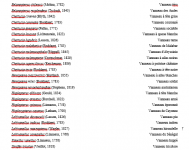-
Welcome to BirdForum, the internet's largest birding community with thousands of members from all over the world. The forums are dedicated to wild birds, birding, binoculars and equipment and all that goes with it.
Please register for an account to take part in the discussions in the forum, post your pictures in the gallery and more.
You are using an out of date browser. It may not display this or other websites correctly.
You should upgrade or use an alternative browser.
You should upgrade or use an alternative browser.
Gruiformes and Charadriiformes (5 Viewers)
- Thread starter Peter Kovalik
- Start date
More options
Who Replied?Acanthis
Well-known member
Absolutely no idea to handle Glareolidae...whose difficulty is not made easier by having the early-diverging genera paraphyletic
Hemerodromus for cinctus, and Macrotarsius for bitorquatus would be a good place to start.
Jim LeNomenclatoriste
Je suis un mignon petit Traquet rubicole

Yes for Hemerodromus (used since long time by myself). Keep bitorquatus in RhinoptilusHemerodromus for cinctus, and Macrotarsius for bitorquatus would be a good place to start.
Jim LeNomenclatoriste
Je suis un mignon petit Traquet rubicole

So, Pluvialis, Pluvialidae or Pluvialinae within Charadriidae ?
Acanthis
Well-known member
Oui! The prodigal plovers return home.😆So, Pluvialis, Pluvialidae or Pluvialinae within Charadriidae ?
Jim LeNomenclatoriste
Je suis un mignon petit Traquet rubicole

Damned. Nul !!! LolOui! The prodigal plovers return home.😆
TomDerutter
Well-known member
"Actophilornis" albinucha sister to Microparra capensis
However the text says "none of the nodes separating the two species of Actophilornis received a bootstrap support value greater than 50%"
However the text says "none of the nodes separating the two species of Actophilornis received a bootstrap support value greater than 50%"
TomDerutter
Well-known member
Given the age of Turnici, Ortyxelos might prove to be a seperate family?currently available sequence data do not even make it possible to test whether Turnix is monophyletic with respect to the monotypic Ortyxelos. We suggest that sequencing the latter genus as well as additional Turnix species should be a priority for future studies seeking to improve taxon sampling within the Charadriiformes
Acanthis
Well-known member
Yes, also subfamily for Oreopholus?The Pluvialiidae-Charadriidae split is old enough to probably still warrant family recognition
For personal reasons. It's on my list and a pretty cool bird🙂
Last edited:
l_raty
laurent raty
They were not critical enough when they included some sequences in their supermatrix, I'm afraid.Look at Lymnocryptes and Rhinoptilus!! 😲😲😲
The position of Lymnocryptes makes no sense, and is likely due to the RAG1 sequence EF373192, which is probably a chimera -- the first 900 bp of the sequence are fully identical to Limosa haemastica. The position of the Long-billed Plover is certainly not correct either, and undoubtedly due to the use of the mitogenome KY419888, which is a Kentish Plover; at least a recent barcode, MT602072, makes Long-billed sister to Little Ringed. The position of Oriental Plover, away from Caspian, is something I cannot believe either...
Jim LeNomenclatoriste
Je suis un mignon petit Traquet rubicole

This species is not even in the figure 🧐Given the age of Turnici, Ortyxelos might prove to be a seperate family?
Acanthis
Well-known member
Back down to Earth with a bang!They were not critical enough when they included some sequences in their supermatrix, I'm afraid.
The position of Lymnocryptes makes no sense, and is likely due to the RAG1 sequence EF373192, which is probably a chimera -- the first 900 bp of the sequence are fully identical to Limosa haemastica. The position of the Long-billed Plover is certainly not correct either, and undoubtedly due to the use of the mitogenome KY419888, which is a Kentish Plover; at least a recent barcode, MT602072, makes Long-billed sister to Little Ringed. The position of Oriental Plover, away from Caspian, is something I cannot believe either...
Thanks Laurent👍
TomDerutter
Well-known member
Yes, this one needs sequencing!This species is not even in the figure 🧐
Jim LeNomenclatoriste
Je suis un mignon petit Traquet rubicole

Can anyone give their opinion on the relationship within Vanellus ? I reduced the number of genera to 8 (previously as many genera as there are species)
Acanthis
Well-known member
Hoploxypterus for cayanus.Can anyone give their opinion on the relationship within Vanellus ? I reduced the number of genera to 8 (previously as many genera as there are species)
Vanellus for vanellus, chilensis and resplendens.
Who knows for the rest.
Jim LeNomenclatoriste
Je suis un mignon petit Traquet rubicole

Chettusia, Lobivanellus, Hoplopterus...Who knows for the rest.
Belonopterus 😏chilensis and resplendens.
.
Acanthis
Well-known member
🤷Chettusia, Lobivanellus, Hoplopterus...
Belonopterus 😏
Jim LeNomenclatoriste
Je suis un mignon petit Traquet rubicole

It's Esacus magnirostris, nested within BurhinusWhat exactly is Burhinus magnirostris in this study?
Jim LeNomenclatoriste
Je suis un mignon petit Traquet rubicole

My lapwing classification





